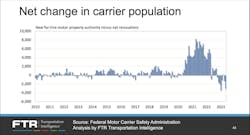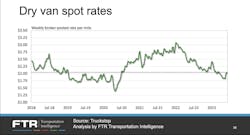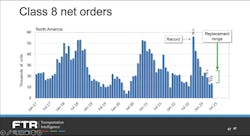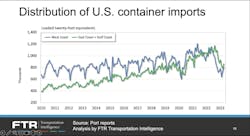Trucking—because of a variety of factors such as a record exodus of fleets and a bottoming spot market—is bleeding capacity, one industry analyst said.
But the slowdown in the freight economy has been like a river in a drought where its level is going down: Other trends of late in related sectors such as ocean shipping, ports and container movements, and intermodal also are starting to become apparent, according to FTR Transportation Intelligence analysts, who spoke during a recent webinar on the state of U.S. freight.
All of them noted trends—and how interconnected trucking is with rail, and how both transport what comes off boats on both coasts of the U.S. and increasingly in other locations such as the Port of Houston.
Fleet failures and the flailing spot market for freight continue to be the story in trucking, Avery Vise, FTR VP of trucking, noted. And capacity is becoming a concern, he added. “We’re clearly starting to lose capacity,” Vise said, also echoing interviews last month with FleetOwner where he revealed an exodus of fleets that reached record levels in the first quarter of 2023 and repeated indicators about the spot market.
See also: Trucking conditions continue to weaken
Trucking outlook, rates, and equipment
“It’s clear we’re losing carriers. Larger carriers are starting to see more pain,” Vise added.
Regarding the spot market, Vise said he and FTR see it normalizing and that spot rates should recover from the monthslong slump by the middle of the third quarter this year.
The latest data shows the middling results that Vise and FTR have been predicting.
FTR’s weekly Spot Market Insights with partner load board Truckstop (the latest available) showed that total spot-market rates in the Truckstop system were essentially unchanged during the week ended June 2, with broker-posted dry van and flatbed spot rates each easing a fraction of a cent while refrigerated spot rates continued to fall modestly after the 29-cent surge during the International Roadcheck inspection blitz two weeks earlier that took capacity off the road through out-of-service violations.
“Spot rates have bottomed out, and we will at worst flatten out,” Vise said.
The FTR VP of trucking noted, however, that while the freight market is in a slowdown, “we haven’t seen a collapse in Class 8 orders.” Healthy backlogs, he noted, have sustained the new equipment market, but warned that orders could fall below replacement level, which generally is just above 10,000 per month.
Class 8 orders came in above expectations in May, reversing the recent downward trend by rising nearly 9% from April levels to 13,600 total tractors, according to FTR. This was relatively in line with the same time last year as orders were only off 2% year-over-year, the industry research firm noted.
And orders for the heaviest over-the-road trucks sagged in April compared to March 2023 by 37% and 39%, respectively, according to two equipment reports put out in early May by FTR and another industry data aggregator, ACT Research.
See also: Class 8 orders rise for first time in months
Orders were down in April for the sixth time in seven months, falling to 12,050 units, according to FTR. Not only was activity down 37% compared to March, but orders fell 20% year-over-year, FTR reported. ACT’s monthly State of the Industry: Classes 5-8 Vehicles report had orders at 11,600 in April, down 27% year-over-year as well 39% lower compared to the previous month.
In a more recent report regarding equipment, released June 12, ACT’s analysts forecasted slight increases in Class 8 retail sales and production volumes later this year, a sign of stronger momentum heading into the third quarter, though the group continues to forecast deteriorating sales and build in Q4.
“The industry is closing in on this cycle’s downward inflection point as strong vehicle production and sales continue in the face of weak freight creation and the exhaustion of pent-up demand in 2023. Collectively, lower freight rates, shrinking carrier profits, higher equipment and borrowing costs, and improved equipment availability put downward pressure on demand overall,” Kenny Vieth, ACT’s president and senior analyst, said in the June 12 blog.
Rail, intermodal, and a shift in port traffic
Todd Tranausky, the FTR VP of rail and intermodal, noted a loss in container traffic and market share at major West Coast ports such as the Ports of Los Angeles and Long Beach, pointing to slides that showed an exodus of intermodal traffic away from the West Coast and adding that “1% might not seem like much, but that is a huge shift.” The Port of Houston, close to the U.S.-Mexico border, has been a beneficiary in the pandemic and post-pandemic movement away from West Coast ports.
“We’re seeing carriers try to develop cross-border business. It’ll be very interesting to watch going forward,” Tranausky noted during the June 8 online discussion.
Intermodal, he also said, will struggle against competition from trucking through 2024.
About the Author
Scott Achelpohl
Managing Editor
Scott Achelpohl is a former FleetOwner managing editor who wrote for the publication from 2021 to 2023. Since 2023, he has served as managing editor of Endeavor Business Media's Smart Industry, a FleetOwner affiliate.





